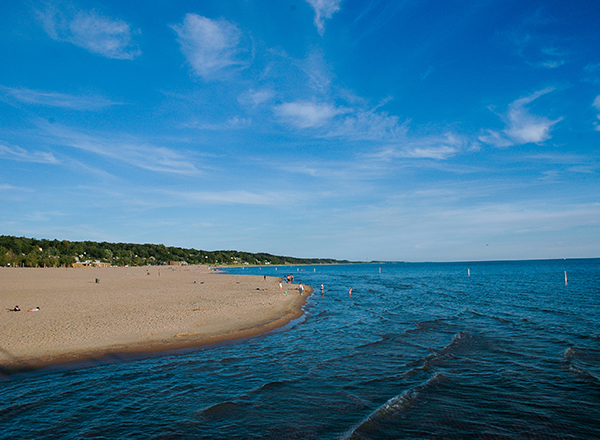How to safely enjoy the Great Lakes

Michigan is one of the best places on earth to enjoy fresh-water recreation. Over the summer, tens of thousands of people will flock to the state’s gorgeous and imposing Great Lakes to enjoy a fun-filled plunge.
It is easy to ignore or underestimate the hazards of rip currents or other hidden dangers on the Great Lakes. Every year, people lose their lives to these hazards in our Great Lakes (and across the country). Being aware and knowing what to do can save your life.
What is a rip current, and why is it so hazardous to swimmers?
A rip current is a type of water current that can occur near beaches with breaking waves. It is a strong, localized, and narrow current of water that moves directly away from the shore, cutting through the lines of breaking waves like a river running out to sea. A rip current is strongest and fastest nearest the surface of the water.
Rip currents can be extremely hazardous and even fatal to swimmers. Swimmers who are caught in a rip current and who do not understand what is happening may not have the necessary skills, they might panic, or might exhaust themselves by trying to swim directly against the incredibly powerful flow of water. Since 2010, rip currents have cost more than 1,000 people their lives on the Great Lakes.
Can you see a rip current?
Sometimes, but not always! Here are signs to look for:
- A narrow gap of darker, seemingly calmer water flanked by areas of breaking waves and whitewater.
- A channel of churning/choppy water that is distinct from surrounding water.
- A difference in water color, such as an area of muddy-appearing water (which occurs from sediment and sand being carried away from the beach).
Any section of water that looks different from the surrounding water might be a warning sign. However, do not rely on vision to keep you safe! If you are already in the water and you drift into a rip current, you won't see it. And, it's not always visible even from shore.
Great Lakes Water Safety Consortium
Jamie Racklyeft, husband of HFC Chair of Communication Media Arts and WHFR General Manager Susan McGraw, almost became one of those statistics. It has been a number of years since Racklyeft nearly drowned in a rip current while vacationing in Michigan’s Leelanau Peninsula. (Read Jamie's story here).
When Racklyeft went for a swim in Lake Michigan on that gorgeous, sunny day in August 2012, he was pulled under by a rip current. He would have died if not for two complete strangers who rescued him on a kayak. Days later, Racklyeft learned that, an hour after he was saved, a 16-year-old boy was caught in the same rip current and drowned. Hearing that news devastated him.
As a result, Racklyeft founded the Great Lakes Water Safety Consortium (GLWSC), a nonprofit organization dedicated to end drowning in the Great Lakes. His efforts got the attention of Channel 4 (WDIV-TV) in Detroit (see video below).
Flip, float, and follow
Here are tips on how to prepare for rip currents when swimming, information for parents and educators, and information for lifeguards and other beach/park employees. If you find yourself caught in a rip current, obey the 3 Fs: flip, float, and follow. Flip onto your back and float. While floating, keep your head above water and conserve energy.
Do not panic; remain calm. This can help save your life.
Follow the safest course to safety:
- Do not fight the rip current
- Follow the rip current to assess which way it’s flowing
- Swim perpendicular to the flow
- If you’re too tired to swim, continue floating to conserve energy
- Signal somebody for help
Other important safety tips for enjoying the Great Lakes!
First, be aware of conditions. Large waves and windy conditions present hazards and should be taken seriously. But even calm days on the Great Lakes require vigilance to recreate safely.
- Never allow young children to swim or wade unsupervised in a lake.
- Young children and learning swimmers should always wear a life vest when swimming or recreating. Experienced swimmers should know the techniques for surviving a rip current and dealing with exhaustion when swimming. Always swim with a partner, and keep an eye on each other.
- Scan the water and remain vigilant if friends or family members are swimming or recreating.
- Look for a beach that has a lifeguard as an extra precaution, but do not rely solely on a lifeguard for your and your family's safety.
- Know your limits as a swimmer. Unless you are a trained lifeguard, do not plunge into a rip current or other hazardous situation in an attempt to rescue a struggling swimmer. Call for help or provide a flotation device. Bring flotation devices with you to the lake.
- Avoid excessive alcohol consumption or consumption of other substances that limit or impair judgment. Spending time in the hot sun can amplify the effects of these substances on your judgment. Stay hydrated (with water or electrolyte-enhanced beverages, not soft drinks or alcohol)!
- Remember that water in the Great Lakes does not only move perpendicular to the shoreline. It also moves parallel to the shoreline. If you are recreating in the water, you may drift upstream or downstream from the section of beach where you started. Be sure to keep an eye on the beach so you know where your starting point is.
- Always wear waterproof sunscreen, and make sure any exposed skin on young children or vulnerable people is covered. A beach umbrella is recommended.
Jamie Racklyeft's survival story
This 2018 video describes how Jamie Recklyeft nearly died, despite knowing what he should do. Strangers saved his life.
